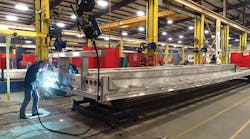A slight improvement in workforce hiring has yet to offset shortages of critical components, leaving trailer and truck manufacturers still chasing production ramp-ups that can meet the hot demand for transportation equipment.
“Material and component supplies, as well as staffing issues, continue to generate headwinds for U.S. trailer OEMs,” said Frank Maly, Director–CV Transportation Analysis and Research at ACT Research, commenting on this quarter’s issue of ACT Research’s Trailer Components Report. “There are some indications that staffing challenges may be easing slightly, and that the upcoming end of supplemental unemployment benefits could further improve workforce availability.”
As a result, pricing and availability of components and materials are resulting in higher trailer prices and a build-up of “red-tag” units—or parked, incomplete units—with the volume of these units expected to continue growing during the upcoming months.
Additionally, the cost of materials makes pricing terms on next year’s orders a gamble for many manufacturers.
“Concerns about future availability and pricing are major factors in the unwillingness of OEMs to accept future orders, which is causing uncertainty about the timing of the ‘official’ opening of the 2022 orders,” Maly said. “In turn, meaningful pent-up demand is occurring due to the reluctance to accept dry van and reefer orders at this time, with the average industry backlog-to-build ratio extending to the end of Q1’22, at June 2021 build rates.”
Correspondingly, July net U.S. trailer orders of 8,128 units fell nearly 26% from the previous month, and were almost 58% lower compared to July of 2020. Before accounting for cancellations, new orders of 9,500 units were down more than 27% versus June, and 53% lower than the previous July, according to this month’s issue of ACT Research’s State of the Industry: U.S. Trailer Report. Year-to-date, however, net orders for the first half of 2021 were up more than 75%, while new orders grew about 52% compared to the COVID-stricken beginning of 2020.
"For reference, remember the order surge that occurred in late 2018, which immediately pushed commitments through Q3 of the next year," Maly said. "A similar pattern could well be in the offing. Of course, pricing, which is still under development, will also have a major impact on that order pace.”
Truck builds tumble
Similarly, Class 8 build rates tumbled in July as medium-duty truck production “also took a step back” as OEMs are robbing Peter to pay Paul with microchips to deliver vehicles.
Indeed, Class 8 OEMs “took down days and weeks” to compensate for component shortages, especially semiconductors. During the month, Class 8 production fell to a 15-month low, as build per available day dropped materially below trend,” according to ACT Research’s latest State of the Industry: NA Classes 5-8 Report.
“Historically, strong orders starting in Q4, the accumulation of large backlogs and growing lead times [BL/BU ratios, or backlog/build] are a recipe for production rising sharply at this point in an industry up-cycle,” said Kenny Vieth, ACT Research’s president and senior analyst. “There are growing pains at the start of every cycle, as the supply chain lurches unevenly into higher build rates, but this pandemic recovery cycle has been beset with extraordinary global issues that have amplified traditional ramp-up challenges from steel supplies to domestic staffing to semiconductors.”
And while production in Classes 5-7 production also fell in July, the decline was more orderly and "in line with expectations,” Vieth noted.
“Like Class 8, the medium duty decline was also the lowest since May 2020’s COVID-shutdown-related output. Additionally, we have heard/read that the heavy-duty OEMs are taking semiconductors away from their medium-duty products to maximize the value of the chips,” he said. “Some large players in the MD space are doing the same thing, using chips that would have been destined for cars and pickups to maintain Classes 5-7 output.”
Used trucks prices remain high
With OEMs unable to meet demand for new trucks, the used truck market is being pinched.
“The bigger issue continues to be the narrative surrounding the trickle of inventory coming into the secondary market from the new truck side of the industry,” said Steve Tam, v.p. at ACT Research, commenting on the preliminary release of the State of the Industry: U.S. Classes 3-8 Used Truck. “Unable to take delivery of new trucks when originally planned, new truck buyers are hanging on to units they had planned to trade. And of course, those new trucks have had their production hampered by pervasive part shortages.”
Pricing will most likely peak around mid-year 2022, based on expected economic/freight activity and forecast supply and demand, Tam added.
“It is important to keep in mind that when the market inevitably slows, it will be doing so from a record level,” he said.
Supporting the ACT research analysis, used truck price appreciation has been “widespread, “with medium-duty trucks prices “particularly” strong, according to July’s Commercial Truck Guidelines by J.D. Power Valuation Services.
Lower-mileage Class 8 trucks are bringing “stratospheric money, the report noted, while the newest available sleep tractors “are breaking records,” up 84% from a year ago.
For medium-duty trucks, Class 3-4 cabover prices were almost 60% higher in the first six months of this year than in 2020, and even 24% higher than for the same period in 2019. Class 6 conventional pricing was 50% in June compared to June 2020.
“We continue to look for an increased volume of fleet trades at auction, and as of this writing in mid-July, we’re not seeing it,” the report by J.D. Power’s Chris Visser states. “Aged and well-used trucks are perhaps showing up in greater numbers, as are day cabs. This activity is what we would expect to see in the very early stages of a return to a normal trade cycle, but for now we’ll just keep an eye on it. As long as new truck availability remains constrained and freight rates keep truckers energized, used truck pricing is on solid footing.”










